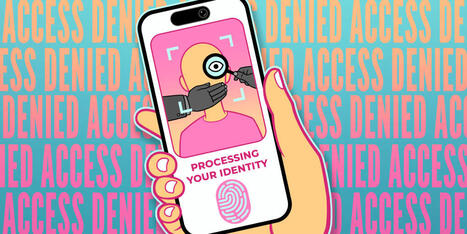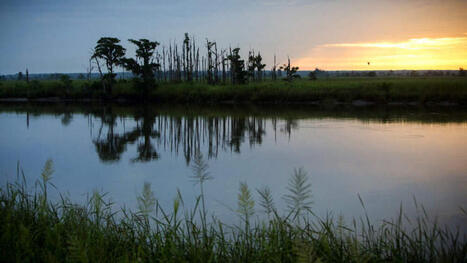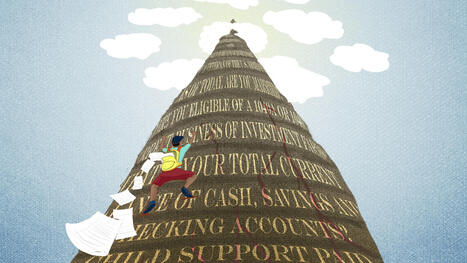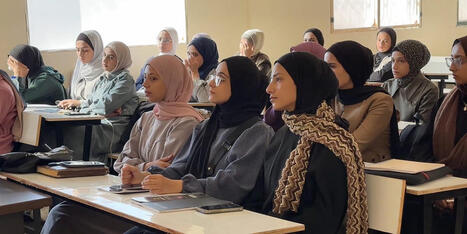 Your new post is loading...
 Your new post is loading...
Astronomers have used the James Webb Space Telescope to confirm the first runaway supermassive black hole, one of the fastest bodies ever seen, pushing a galaxy-worth of material ahead of it and forming stars in its wake.
What if a portrait didn’t just represent someone, but remembered them? 𝑮𝒂𝒔𝒌𝒊𝒏𝒔 𝒇𝒂𝒄𝒆𝒔 𝒕𝒉𝒆 𝒗𝒊𝒆𝒘𝒆𝒓 𝒅𝒊𝒓𝒆𝒄𝒕𝒍𝒚, 𝒇𝒓𝒂𝒎𝒆𝒅 𝒃𝒚 𝒂 𝒓𝒊𝒏𝒈 𝒐𝒇 𝒄𝒐𝒍𝒐𝒖𝒓𝒆𝒅 𝒃𝒍𝒐𝒄𝒌𝒔 𝒕𝒉𝒂𝒕 𝒔𝒊𝒕𝒔 𝒔𝒐𝒎𝒆𝒘𝒉𝒆𝒓𝒆 𝒃𝒆𝒕𝒘𝒆𝒆𝒏 𝒔𝒕𝒂𝒊𝒏𝒆𝒅 𝒈𝒍𝒂𝒔𝒔 𝒂𝒏𝒅 𝒊𝒏𝒕𝒆𝒓𝒇𝒂𝒄𝒆. 𝑯𝒆𝒓 𝒃𝒓𝒂𝒊𝒅𝒆𝒅 𝒉𝒂𝒊𝒓 𝒂𝒏𝒅 𝒑𝒂𝒕𝒕𝒆𝒓𝒏𝒆𝒅 𝒔𝒄𝒂𝒓𝒇 𝒑𝒍𝒖𝒈 𝒊𝒏𝒕𝒐 𝒕𝒉𝒊𝒔 𝒔𝒕𝒓𝒖𝒄𝒕𝒖𝒓𝒆 𝒔𝒐 𝒕𝒉𝒂𝒕 𝒇𝒊𝒈𝒖𝒓𝒆 𝒂𝒏𝒅 𝒃𝒂𝒄𝒌𝒈𝒓𝒐𝒖𝒏𝒅 𝒇𝒆𝒆𝒍 𝒍𝒊𝒌𝒆 𝒐𝒏𝒆 𝒄𝒊𝒓𝒄𝒖𝒊𝒕. 𝑻𝒉𝒆 𝒔𝒆𝒍𝒇-𝒑𝒐𝒓𝒕𝒓𝒂𝒊𝒕 𝒒𝒖𝒊𝒆𝒕𝒍𝒚 𝒔𝒕𝒂𝒕𝒆𝒔 𝒊𝒕𝒔 𝒑𝒐𝒔𝒊𝒕𝒊𝒐𝒏: 𝒂𝒏 𝒂𝒓𝒕𝒊𝒔𝒕 𝒘𝒉𝒐 𝒊𝒏𝒔𝒆𝒓𝒕𝒔 𝒉𝒆𝒓 𝒐𝒘𝒏 𝒑𝒓𝒆𝒔𝒆𝒏𝒄𝒆 𝒂𝒕 𝒕𝒉𝒆 𝒄𝒆𝒏𝒕𝒓𝒆 𝒐𝒇 𝒕𝒉𝒆 𝒕𝒆𝒄𝒉𝒏𝒐𝒍𝒐𝒈𝒊𝒄𝒂𝒍 𝒂𝒏𝒅 𝒄𝒖𝒍𝒕𝒖𝒓𝒂𝒍 𝒔𝒚𝒔𝒕𝒆𝒎𝒔 𝒔𝒉𝒆 𝒘𝒐𝒓𝒌𝒔 𝒘𝒊𝒕𝒉, 𝒓𝒂𝒕𝒉𝒆𝒓 𝒕𝒉𝒂𝒏 𝒂𝒕 𝒕𝒉𝒆𝒊𝒓 𝒎𝒂𝒓𝒈𝒊𝒏. Dr. Nettrice R. Gaskins is a digital artist, educator, and cultural critic whose practice bridges algorithmic art, Afrofuturism and STEAM learning. She holds a BFA in Computer Graphics (Pratt Institute, 1992), an MFA in Art & Technology (School of the Art Institute of Chicago, 1994) and a PhD in Digital Media (Georgia Tech, 2014). Her work includes AI‑generated portrait series exhibited at the Smithsonian Arts and Industries Building and large‑scale murals in Brooklyn. In a AI market flooded by generative portraits, emotional rarity is the new blue chip. Nettrice R. Gaskins doesn’t generate faces—she constructs legacies. Each portrait she creates becomes a vessel of symbolic memory, not just an AI artifact.
The most affordable of all the federal repayment programs is ending sooner than planned after Trump conspired with red-state attorneys general to kill it.
Recently, for reasons both generational and chronological, I find myself looking back at people who have helped shape my life, writes David Tanklefsky. Some of them know their impact, but not all.
Students are using AI tools more than ever. An Angelo State University professor designed a way to figure out if his students were using artificial intelligence on a recent paper. We speak with Will Teague, who says students are sacrificing their own agency to artificial intelligence.
The department said recalling these fired staffers would "bolster and refocus" civil rights enforcement "in a way that serves and benefits parents, students, and families."
In both parties, the share that say the higher education system is going in the wrong direction has gone up by at least 10 percentage points since 2020.
Only five of the agency’s civil rights offices remain nationwide. Those who are still with the department say it will now be “virtually impossible” to resolve discrimination complaints.
The artwork had been hanging at San Francisco International Airport for months, largely unnoticed by the crowds streaming through Harvey Milk Terminal 1. But a social media post this week changed everything. A digital portrait series by Boston-based artist and educator Nettrice Gaskins, featured in SFO Museum’s “Women of Afrofuturism” exhibition, has unexpectedly become the latest flashpoint in an intensifying debate over artificial intelligence and the future of creative work. Though the show opened in May, it only recently came under scrutiny after a video uploaded to the Bay Area subreddit circulated widely, drawing thousands of comments — many sharply critical of the airport’s decision to display AI-generated art. The controversy comes at a moment of broader unease across the creative economy.
French marine archaeologists have discovered a massive undersea wall off the coast of Brittany, dating from around 5,000 BC. They think it could be from a stone age society whose disappearance under rising seas was the origin of a local sunken city myth. The 120-metre (394ft) wall – the biggest underwater construction ever found in France – was either a fish-trap or a dyke for protection against rising sea-levels, the archaeologists believe. When it was built on the Ile de Sein at Brittany's western tip, the wall would have been on the shore-line – between the high and low tide marks. Today it is under nine metres of water as the island has shrunk to a fraction of its former size.
Between September and November, 2.41 inches of rain fell -- more than what typically falls in the desert landscape in one year. An ancient lake that once existed at Death Valley National Park has reemerged after record rainfall in the region. Several inches of water have formed in Badwater Basin, which lies at 282 feet below sea level, the lowest point in North America, according to a press release from the National Park Service. During the Ice Ages, the basin -- colloquially known as Lake Manly -- was once a lake with depths of up to 700 feet.
To see the works by one of the top virtuoso portraitists of the 20th century, drop into the home that Nicolai Fechin designed and built for his family in Taos, New Mexico. Masterful oil and charcoal portraits created throughout his life are hung in quiet, contemplative corners of his spectacular 1920s home as part of Masterful Expression: Nicolai Fechin’s Portraiture, on view at the Taos Art Museum at Fechin House through December 31, 2025. The house itself is a masterwork with all the doors, railings, and embellishments carved by Fechin’s own hand, but the portraits and small, carved wooden busts show why he is considered one of the greatest Russian artists ever to take up residency in the United States.
GOP funding cuts mean that more children will grow up with the lifelong implications of untreated illnesses.
|
Amazon Business is billed as a convenient one-stop shop for schools. Reality is more expensive. For over two decades now, Amazon has been seen as a one-stop shop to buy virtually anything, and get it delivered in no time flat. It’s been estimated that the platform has over 310 million active users, and just in the U.S. during 2023, sold over 4.5 billion items. Amazon claims to be guided by four principles: “customer obsession rather than competitor focus, passion for invention, commitment to operational excellence, and long-term thinking.” Certainly there is a very large quantity of retail items for sale on the platform, even if their quality or identity may be questionable. But in another much more obscure part of the business, Amazon’s supposed obsession with its customers and “commitment to operational excellence” falls flat.
Age verification laws are proliferating fast across the United States and around the world, creating a dangerous and confusing tangle of rules about what we’re all allowed to see and do online. That's why today, we're launching EFF.org/Age, a one-stop shop for users seeking to understand what these laws actually do, what’s at stake, why EFF opposes all forms of age verification, how to protect yourself, and how to join the fight for a free, open, private, and yes—safe—internet.
Between now and the end of the century, climate change will trigger a cascade of rapid, irreversible environmental changes that will make it impossible for people to establish a sense of place, writes Frederick Hewett.
"Pigeons are having a moment,” I tell my friend. “Tove,” she kindly says, “I think that’s just your algorithm.” When I scroll through my Instagram feed, I see a video of someone putting makeup on to look like a pigeon. Then there’s a pigeon using a water bottle refilling station to take a nice little bath. An illustrated ode to pigeons. Someone dresses up like a pigeon and visits New York City’s “pigeon house.” There’s a gigantic pigeon sculpture on display at The High Line through spring 2026. PBS just aired a new documentary called "The Pigeon Hustle,” which reveals the secret world of urban pigeons. I heard about the documentary on social media, too. And, yes, it does appear that over half of the pigeon videos I’ve been watching were “suggested posts” — not content from people I follow. The algorithm has correctly deduced that I will stop scrolling to watch if there’s a pigeon on the screen. Yet I also wonder if the algorithm itself is behind my love of pigeons.
Legal challenges put SAVE borrowers in limbo for months, a time during which they were not required to make payments on their loans. That would change if the proposed settlement is approved.
This year's federal aid form is new and improved. But it came three months later than normal, and in its first week, online access has been unpredictable.
What is at stake is far more than a rejection of gangster capitalism and the global misery it produces. The deeper danger lies in recognizing that education has become the primary battlefield in the cultural and ideological wars waged by authoritarianism. Neoliberal capitalism, in its fascist mutation, does not simply impoverish; it seeks to colonize consciousness, to erode the capacity for critical thought, and to replace democratic imagination with the deadening certainties of hierarchy and fear. Universities now sit at a dangerous crossroad where truth is contested, civic memory is either erased or preserved, and the formative conditions for democratic life are nourished, or systematically destroyed. To defend higher education, then, is to reclaim its power to cultivate the forms of agency, solidarity, and critical awareness necessary to challenge the lies, brutalities, racism, corruption, and manufactured ignorance that sustain authoritarian rule.
My work connects to the concept of cultural war primarily as a cultural critic and academic who writes about representation, identity, and the role of art and technology in challenging the status quo. For Art21 I examined the “American Culture Wars” of the 1980s and 1990s, which were fought over issues of identity politics and the exclusion of underrepresented minorities in the arts: "[C]ulture wars are intellectual, political, religious, and/or social conflicts over cultural pluralism in Western societies. Culture wars have polarized Americans over social issues such as race and representation, education..." The theme of my essay was multiculturalism that offered a distinct culture war fought over issues of exclusion and identity politics. By the 1990s, multiculturalism had become an all-purpose word that evoked a range of meanings and implications. However, with the back-to-back elections of President Barack Obama, the U.S. entered an illusory period of “post-racialism” when the decades-old fight for inclusion and racial equity was side-lined. Many people bought into the idea that racial prejudice no longer existed or was no longer seen as a major social problem. In reality, there was a movement growing in power to dismantle civil rights legislation and affirmative action through litigation and policy changes. Some might say that post-racial backlash led to the election and re-election of Trump.
In American high schools, many teenagers are assigned few full books to read from beginning to end — often just one or two per year, according to researchers and thousands of responses to an informal reader survey by The New York Times.
GAZA CITY—On December 1, Mohammed Hossam Ashour stood inside one of the two remaining buildings of Islamic University in Gaza City. A 19-year-old information technology major, he was attending in-person lectures for the first time in two years after the university resumed classes in late-November. “We are happy to be beginning our return to something of a normal life, even if in a small way, to be returning to in-person learning after having been absent for more than two years because of the war the Israeli occupation waged against us,” Ashour told Drop Site News. “Despite the challenges, and despite the fact that more than 90 percent of the buildings at the Islamic University have been destroyed, the university still repaired and restored the buildings that could be used for teaching and made them available for the students so they could attend their lectures and come regularly to Islamic University.” Like every other university in Gaza, Islamic University was targeted by the Israeli military during its genocidal assault. Once one of the largest universities in Gaza, with about 17,000 students before the war—60 percent of them women—nearly every building on the campus is now a bombed-out, hollow shell. Many of the roofs are pancaked in and the auditoriums have been gutted and burned. Hundreds of displaced families have set up tents in the rubble-filled courtyard and sought shelter in lecture halls and classrooms.
The Geminids are particularly spectacular because of the amount of meteors people can see. When stargazing from a dark location, sky gazers can expect to see a meteor every minute or so during the peak.
I learned about this on an online forum, but I found it interesting. Here’s a description from the YouTube description… Recorded on September 24, 2025. NCompass Live - https://nlc.nebraska.gov/ncompasslive/ Special monthly episodes of NCompass Live! Join the NLC’s Technology Innovation Librarian, Amanda Sweet, as she guides us through the world of library-related 'Pretty Sweet Tech'.…
|




 Your new post is loading...
Your new post is loading...



























